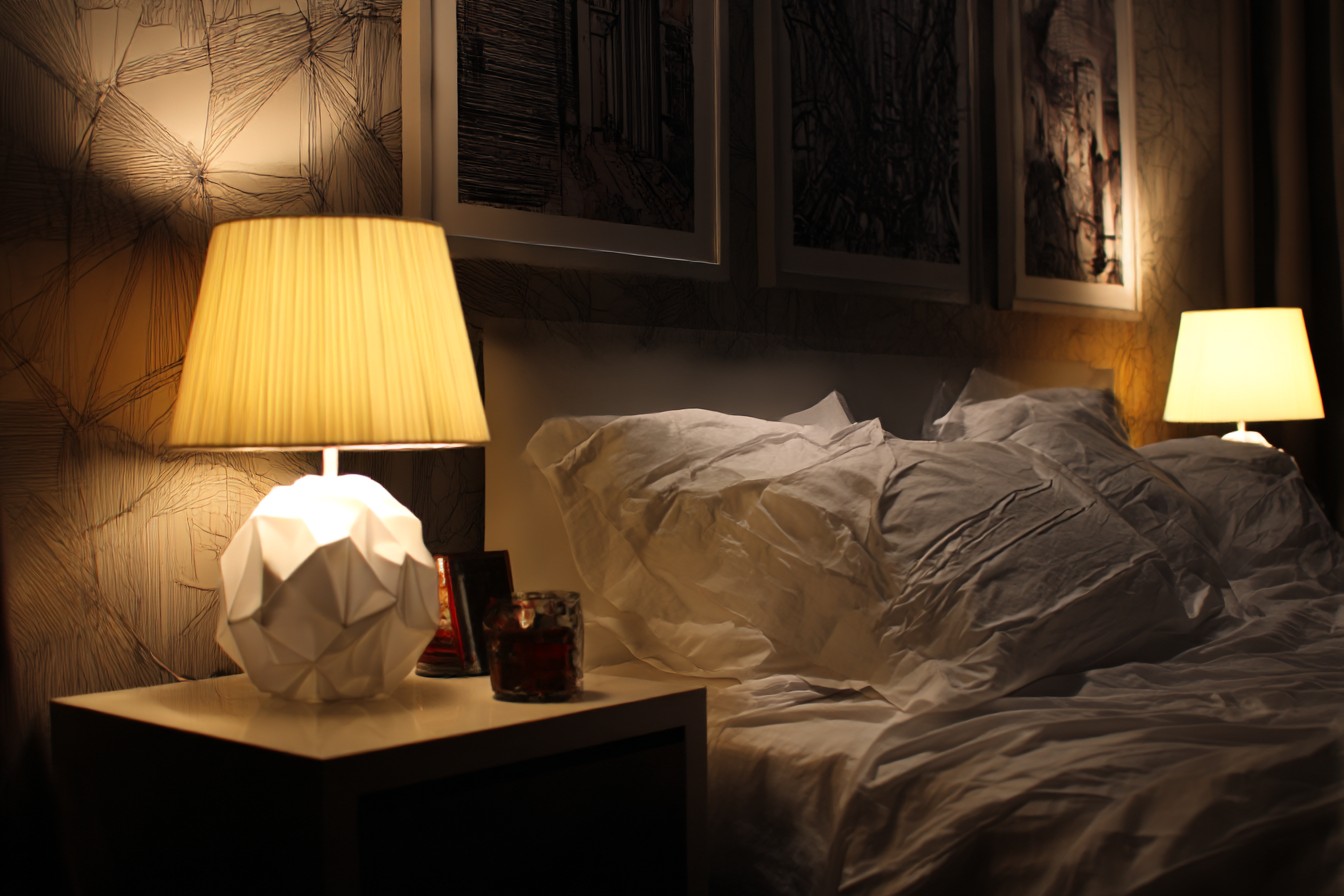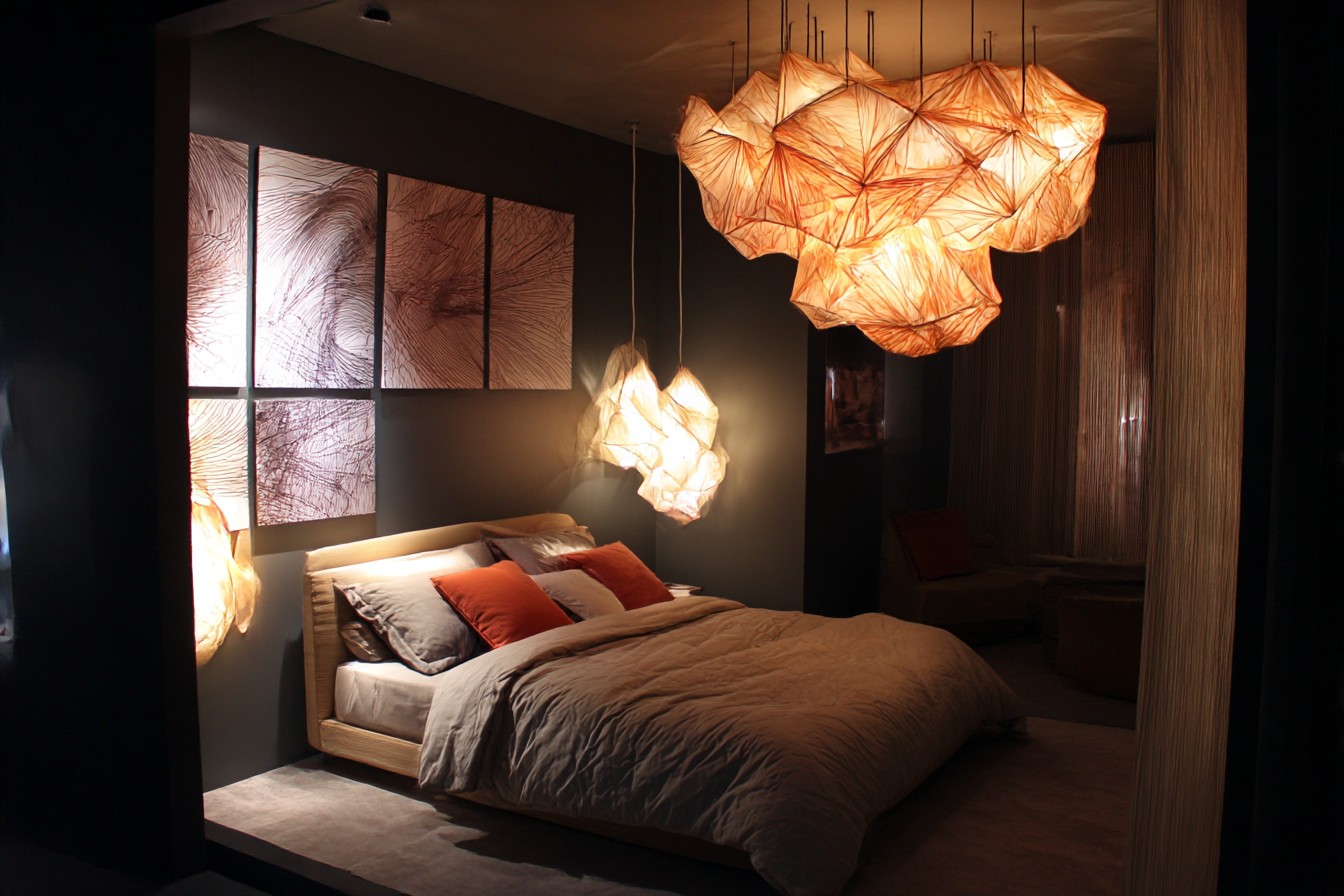The worst bedroom lighting I’ve ever experienced was in my first London flat share. The landlord’s idea of adequate illumination was a single overhead bulb so harsh it made autopsy tables look cozy. My girlfriend at the time (now my long-suffering wife Charlotte) refused to stay over, claiming the lighting made her feel like she was “being interrogated rather than romanced.” She wasn’t wrong. The place had all the ambience of a multi-storey car park.
I still remember the Sunday afternoon when, fed up with squinting at books and Charlotte’s continued resistance to visiting, I took matters into my own hands. Armed with a cheap floor lamp from Argos, a string of fairy lights nicked from my flatmate’s Christmas box, and absolutely zero knowledge of electrics, I set about creating what I grandly called “layered lighting.” The result was… well, marginally better than before, though the extension lead daisy-chain across the floor prompted my flatmate to dub it “The Fire Hazard Special.”
Twenty years and several homes later, I’ve learned a thing or two about proper bedroom lighting. Not from architecture school, mind you—where we spent far more time discussing the metaphysical qualities of light than the practical matter of helping someone find a pair of matching socks at 6am—but from trial, error, and listening to Charlotte’s increasingly specific feedback.

The fundamental problem with most British bedroom lighting schemes is that they’re stuck in a weird time warp. We’ve got these beautiful period homes with their high ceilings and generous proportions, yet we’re still relying on a single central pendant and maybe—if we’re feeling particularly sophisticated—a matching pair of bedside lamps. It’s like owning a fantastic sound system but only ever playing music through a single tinny speaker. You’re missing out on the full experience, love.
Proper bedroom lighting isn’t just about being able to see. It’s about creating a space that can transition smoothly from practical morning routines to evening relaxation. It’s about highlighting the room’s best features while disguising its flaws (and let’s be honest, every British bedroom has at least one questionable feature—mine’s currently the slightly wonky Victorian coving that no amount of careful plastering has been able to truly fix).
Let’s talk about the three essential layers your bedroom lighting needs, because yes, it’s actually that simple: ambient, task, and accent. Sorted.
Ambient lighting is your room’s base layer—the general illumination that lets you see where you’re going without tripping over the laundry basket. Traditionally, this is that central pendant light we all grew up with. But here’s where most bedrooms go wrong: relying solely on overhead lighting is about as flattering as a passport photo booth and roughly as relaxing as the lighting at a Tesco Express at 2am.
In our current 1950s semi, I’ve supplemented the central light with uplighters tucked into corners. Dead simple, these are—just floor lamps that point upward, bouncing softer light off the ceiling rather than beaming it directly into your face like you’re being caught escaping from Colditz. Cost me about £40 each from John Lewis (on sale, I’m not made of money), but they’ve transformed how the room feels. The light diffuses across the ceiling, creating a gentler overall glow that doesn’t create those harsh shadows that make you look like you’ve aged ten years each time you glance in the mirror.

Another option—and this worked brilliantly in our old Victorian place with its ornate picture rails—is LED strip lighting hidden along architectural features. Sounds fancy, doesn’t it? In reality, it was about £30 worth of LED strips from Screwfix and an afternoon of careful positioning. The light washed up across the ceiling and highlighted the original cornicing while keeping the actual source hidden. Visitors always commented on the “pleasant atmosphere” without being able to identify exactly why the room felt so comfortable.
Next up, task lighting. This is what lets you actually do things in your bedroom besides sleep—reading, getting dressed, finding that earring you dropped somewhere in the carpet pile. Bedside lamps are the obvious starting point, but they’re often poorly chosen and badly positioned.
Charlotte and I spent years with mismatched bedside lamps that were too short, forcing us to contort ourselves into bizarre positions just to read a few pages before sleep. The light would hit the page at exactly the wrong angle, creating shadows across every paragraph. She’d end up with a stiff neck, I’d give up and play on my phone instead, and we’d both wake up feeling like we’d been folded into strange origami shapes overnight.
Getting the height right is essential—the bottom of the lampshade should be roughly at shoulder height when you’re sitting up in bed, which for most standard UK divan beds means a lamp around 65-70cm tall or a shorter lamp on a stack of books (my temporary solution for years). The shade should be wide enough to cast light across your book or tablet but not so wide it encroaches on precious bedside table real estate. And for God’s sake, make sure you can actually reach the switch without performing advanced yoga.
In our current bedroom, I’ve mounted adjustable wall lights instead. These swing-arm beauties from a little independent shop in Manchester cost more than I’d care to admit to my father (who still believes all light fittings should cost under £20), but they’ve been worth every penny. They free up space on our modestly sized bedside tables, provide perfectly positioned light for reading, and can be tucked away when not needed. The added bonus is that they’ve got those little LED bulbs that last approximately forever, which means I haven’t had to balance precariously on the bed to change a bulb in nearly four years.

Task lighting isn’t just about reading, though. If you’ve got a dressing table or wardrobe area, proper lighting there will save you from that classic British experience of leaving the house thinking you look presentable only to catch your reflection in a shop window and discover your shirt is actually two noticeably different shades of navy. Been there, haven’t we all?
For Charlotte’s dressing table, we installed a simple LED mirror with adjustable brightness. Cost about £120 from Argos, took me all of 15 minutes to mount on the wall (a personal record for any electrical installation), and has eliminated at least three arguments per month about whether her makeup looks “cakey” (her concern) or “completely fine” (my standard, not particularly helpful response).
Now for the final layer—accent lighting, or what I like to call the “makes your bedroom look like you actually care about it” lighting. This is where you highlight the good bits, create atmosphere, and generally elevate your room from “place where sleep happens” to “proper grown-up sanctuary.”
In our Victorian terrace, we had a beautiful cast iron fireplace that previous owners had painted an offensive shade of orange. Rather than strip it back immediately (a job that eventually took me three weekends and permanently stained my favorite jeans), we strategically placed a small uplight behind it, casting dramatic shadows across the chimney breast. Visitors thought it was a deliberate design choice rather than a “we’ll get around to fixing that eventually” feature.
Our current bedroom has a rather lovely collection of framed botanical prints that Charlotte inherited from her grandmother. Instead of the standard central overhead light casting shadows across them, we’ve installed picture lights above each one. Not the battery-operated stick-on rubbish, mind you—proper, wired-in slimline LED picture lights that cast a warm glow across the artwork. They’re connected to a dimmer switch by the door, which means we can create instant atmosphere when needed or turn them up to appreciate the delicate details of the illustrations.

The corners of bedrooms are often neglected, creating those pools of darkness that make even the nicest room feel a bit gloomy. A simple table lamp on a chest of drawers, a slender floor lamp tucked beside a chair, or even a salt lamp on a shelf (Charlotte’s contribution to the lighting scheme, which I initially mocked but have grown to appreciate) can eliminate those dark zones and make the room feel larger and more balanced.
The real magic happens when you connect different lighting elements to separate switches, allowing you to control the mood. In an ideal world, you’d have separate circuits professionally installed during a renovation, but if you’re working with an existing setup like most of us, smart bulbs are the answer. Yes, I was skeptical too—my father practically had an aneurysm at the concept of light bulbs needing WiFi—but they’ve been revolutionary for our bedroom.
We’ve got the overhead light, bedside lamps, and accent lighting all connected to a system we can control from our phones or by asking that little listening device whose name I won’t mention because it sometimes thinks I’m talking to it. The ability to shift from “full brightness for changing the bedding and finding that missing sock” to “subdued evening mode for a glass of wine and conversation” without moving from the bed feels ridiculously luxurious for such a simple technology.
The whole setup—replacing outdated fittings, adding new light sources, and connecting everything to a smart system—cost less than £500 spread over several months. Not insignificant, I know, but considering we spend roughly a third of our lives in our bedrooms, it’s been money well spent. The improvement to both functionality and atmosphere has been dramatic, and Charlotte no longer claims that getting undressed in our bedroom makes her feel like she’s “changing under a motorway streetlight,” which I count as a definite win.
So if you’re still relying on that single overhead light and maybe a mismatched pair of bedside lamps that you’ve had since university, do yourself a favor and think about proper lighting layers. Your bedroom should work as hard as the rest of your home at making your life both practical and pleasant. And trust me on this—no single lighting source is ever going to do both jobs properly, no matter what the bloke at B&Q tells you. After all, there’s a reason why professional photographers use multiple light sources, and they’re not even trying to create a space where you can both find a specific pair of socks AND feel romantically inclined within the span of a few hours. Though come to think of it, maybe that IS what photographers are doing… but that’s a topic for someone else’s blog, innit?